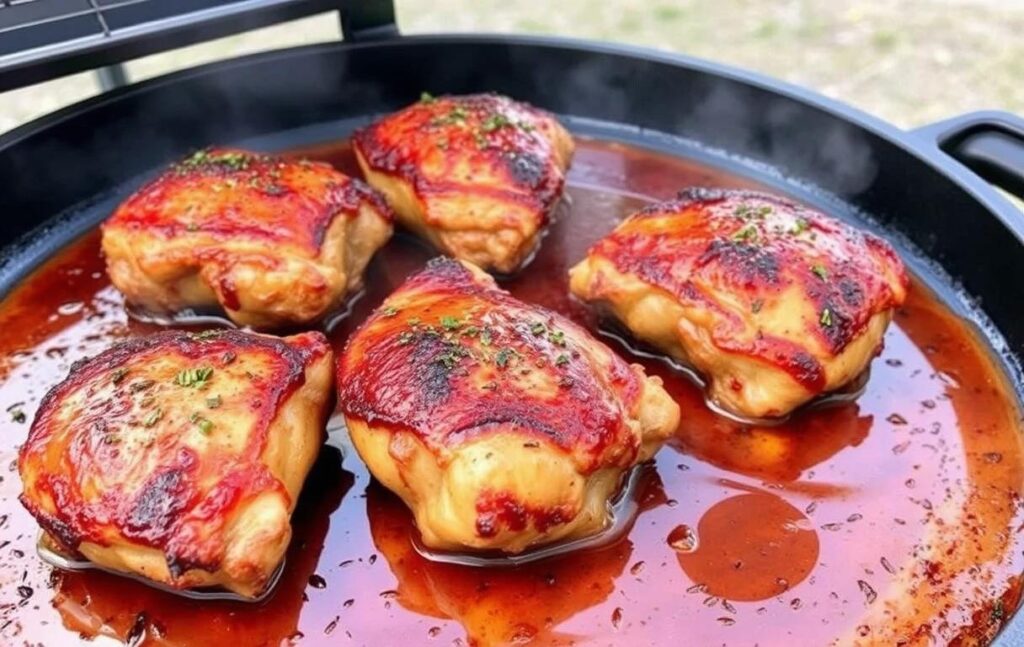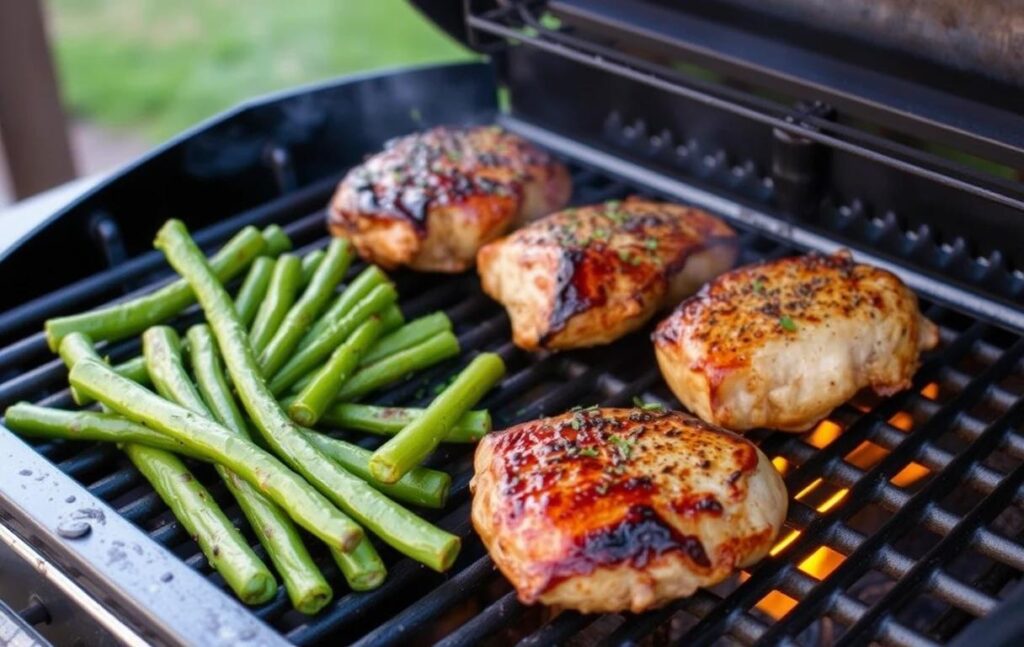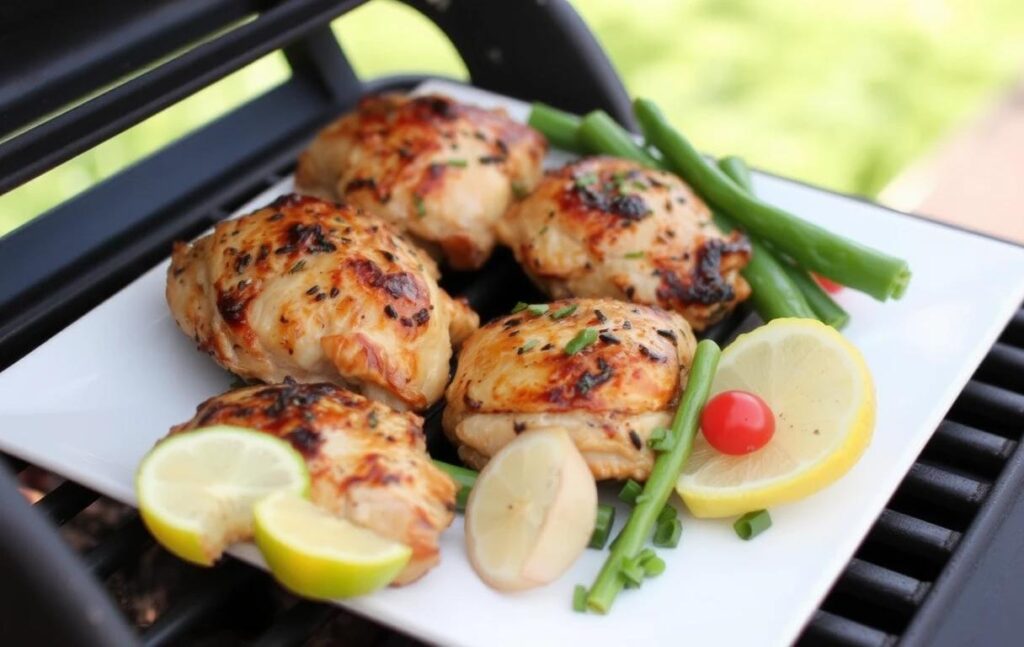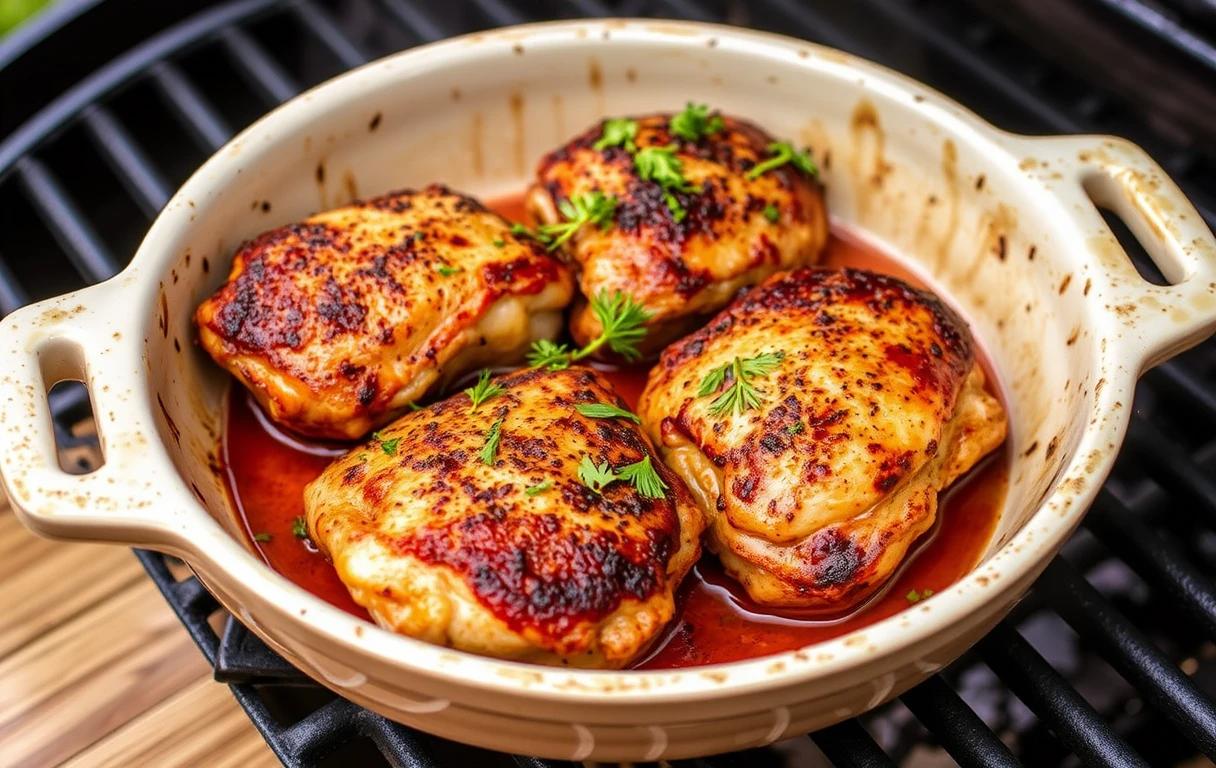chicken thighs on pellet grill:
Grilling chicken thighs is a culinary adventure that promises rich flavors and juicy textures, making it a favorite for many backyard chefs. Among various grilling methods, the pellet grill stands out as a game-changer, offering unmatched convenience and precision. Unlike traditional grills, a pellet grill combines the smoky richness of wood-fired cooking with the modern ease of temperature control, ensuring perfectly cooked chicken thighs every time.
Whether you’re a seasoned pitmaster or a grilling novice, this guide will take you through everything you need to know to master the art of cooking chicken thighs on a pellet grill. From preparation and seasoning to achieving that perfect smoky flavor, you’ll discover tips and techniques to elevate your grilling game.
Understanding Chicken Thighs and Benefits of Using a Pellet Grill
Understanding Chicken Thighs
Chicken thighs are a versatile and flavorful cut of meat that’s perfect for grilling. Here’s a breakdown of the types of chicken thighs to help you choose the best for your pellet grill:
- Bone-In vs. Boneless Thighs
- Bone-In Thighs: These retain their natural juices better during cooking, resulting in a richer flavor. They take a bit longer to cook but are worth the wait for their succulence.
- Boneless Thighs: Faster to cook and easier to eat, boneless thighs are ideal for marinades and quick grilling. They’re slightly less juicy than their bone-in counterparts but still packed with flavor.
- Skin-On vs. Skinless Thighs
- Skin-On Thighs: The skin crisps beautifully on a pellet grill, adding a delicious, smoky crunch. It also helps lock in moisture, keeping the meat juicy.
- Skinless Thighs: These are a leaner option, great for those watching fat intake. Without the skin, it’s essential to use marinades or bastes to prevent drying out.
- Size and Uniformity
- Opt for thighs of similar size to ensure even cooking. If the thighs vary significantly, larger ones may remain undercooked while smaller ones dry out.
Benefits of Using a Pellet Grill
A pellet grill is not just a tool; it’s an ally for anyone aiming to achieve perfectly grilled chicken thighs. Here’s why it’s the go-to choice for many grill enthusiasts:
- Precision Temperature Control
- Pellet grills operate like an oven, allowing you to set and maintain precise temperatures. This feature ensures chicken thighs cook evenly without overcooking or drying out.
- Consistent Smoke Flavor
- Unlike charcoal or gas grills, pellet grills infuse food with a steady and controlled stream of smoke. This results in a subtle, mouthwatering flavor that pairs perfectly with chicken.
- Ease of Use
- With automatic ignition and temperature regulation, pellet grills eliminate much of the guesswork involved in grilling. They’re beginner-friendly while still offering the versatility seasoned grillers crave.
- Versatile Cooking Options
- Beyond grilling, a pellet grill can smoke, roast, bake, and even braise. This versatility makes it ideal for preparing not just chicken thighs but a wide range of dishes.
- Wide Range of Wood Pellet Flavors
- You can experiment with different wood pellet varieties like hickory, apple, or mesquite to customize the flavor profile of your chicken thighs.
- Efficient and Clean Burning
- Pellet grills burn wood pellets efficiently, leaving behind minimal ash. This makes cleanup easier and helps maintain the grill in top condition.
Preparing Chicken Thighs for the Grill and Selecting the Right Pellets

Preparing Chicken Thighs for the Grill
Proper preparation is key to achieving tender, flavorful chicken thighs on a pellet grill. Follow these steps to set yourself up for success:
- Cleaning and Trimming
- Rinse the Thighs: Quickly rinse the chicken thighs under cold water to remove any residue from packaging. Pat them dry with a paper towel to ensure the seasoning adheres well.
- Trim Excess Fat: Use a sharp knife to trim any excess skin or fat. Leaving a thin layer of skin ensures crispy results, but too much can result in flare-ups or an overly greasy texture.
- Seasoning Options
- Dry Rubs: Create a flavorful crust by massaging a dry rub into the thighs. Popular rubs include a mix of paprika, garlic powder, onion powder, black pepper, and brown sugar. Experiment with spices to suit your taste.
- Marinades: For deeper flavor, marinate the thighs for 2–6 hours. A basic marinade might include olive oil, lemon juice, soy sauce, garlic, and herbs. Acidic ingredients tenderize the meat while adding zest.
- Tools Needed for Preparation
- Meat Thermometer: Essential for checking doneness. Chicken thighs should reach an internal temperature of 165°F (74°C).
- Basting Brush: Useful for applying marinades or sauces during cooking.
- Sharp Knife: For trimming and portioning.
- Mixing Bowls: To mix and apply rubs or marinades.
- Brining for Extra Juiciness
- Soak the chicken thighs in a simple brine (water, salt, sugar) for 1–2 hours before grilling. This step helps retain moisture and enhances flavor.
- Room Temperature Rest
- Let the thighs sit at room temperature for 20–30 minutes before grilling. This ensures even cooking and prevents the meat from seizing when exposed to heat.
Selecting the Right Pellets
The type of wood pellets you use has a significant impact on the flavor of your chicken thighs. Here’s how to make the right choice:
- Popular Pellet Types for Chicken
- Hickory: A strong, smoky flavor that works well with barbecue rubs.
- Applewood: Slightly sweet and fruity, perfect for lighter marinades.
- Cherry: Adds a subtle sweetness and enhances the chicken’s appearance with a reddish hue.
- Pecan: A mild, nutty flavor that complements herb-based seasonings.
- Mesquite: Bold and intense, ideal for spicy or savory dishes.
- Blending Pellets for Unique Flavors
- Combine pellets like hickory and apple for a balanced smoky-sweet taste. Experiment with blends to find your favorite combination.
- Quality Matters
- Choose high-quality pellets from trusted brands to ensure clean burning and consistent smoke. Low-quality pellets may produce excessive ash or an unpleasant aftertaste.
- Storage Tips
- Keep pellets dry to prevent them from clumping or losing their effectiveness. Store them in a sealed container in a cool, dry place.
- Matching Pellets with Seasonings
- Pair the pellet flavor with the profile of your seasoning. For instance, apple or cherry wood complements sweet or fruity marinades, while mesquite or hickory enhances bold, smoky rubs.
Setting Up the Pellet Grill and Smoking vs. Grilling Techniques
Setting Up the Pellet Grill
A well-prepped pellet grill ensures consistent cooking and flavorful results. Here’s how to set it up step by step:
- Inspect the Grill
- Before starting, check the hopper for leftover pellets and refill if necessary. Use fresh pellets for optimal smoke and flavor.
- Clean the grill grates and empty the grease tray to avoid flare-ups and ensure even cooking.
- Preheat the Grill
- Power on the pellet grill and set the temperature to 225°F (107°C) for smoking or 375°F (190°C) for direct grilling.
- Allow the grill to preheat for 10–15 minutes with the lid closed. This ensures a stable temperature and primes the grill for consistent smoke.
- Load the Pellets
- Fill the hopper with your chosen wood pellets (e.g., hickory, apple, or cherry). Use enough to last the entire cooking time to prevent interruptions.
- Prepare the Cooking Area
- Arrange the grill grates or use a disposable aluminum pan for easier cleanup.
- Apply a light coat of cooking spray or oil to the grates to prevent sticking, especially if using skinless chicken thighs.
- Check Smoke Flow
- Look for a steady stream of light, blue smoke from the grill. Thick white smoke can impart a bitter taste and indicates incomplete combustion.
- Stabilize Temperature
- Monitor the temperature on the built-in thermometer or with a separate grill probe. Pellet grills are highly precise, but a slight fluctuation is normal.

Smoking vs. Grilling Techniques
Both smoking and grilling have their unique advantages. Choosing the right method depends on your desired results:
- Smoking Chicken Thighs
- Temperature: Set the grill to 225°F (107°C) for low and slow cooking.
- Process: Place the chicken thighs on the grill grates, skin side up, and let the smoke infuse the meat for 1.5–2 hours.
- Advantages: Smoking enhances the chicken with deep, wood-fired flavor and keeps it incredibly moist.
- Tip: For crispy skin, finish the thighs at a higher temperature (375°F or 190°C) for 5–10 minutes.
- Grilling Chicken Thighs
- Temperature: Preheat the grill to 375°F (190°C) for direct grilling.
- Process: Cook the thighs directly over the heat for 6–8 minutes per side, flipping occasionally.
- Advantages: Grilling delivers crispy skin and caramelized edges in less time than smoking.
- Tip: Use a meat thermometer to ensure the internal temperature reaches 165°F (74°C).
- Combining Techniques
- Start with smoking at a low temperature to build flavor, then finish with grilling for a crispy exterior. This hybrid method offers the best of both worlds.
- Adjusting for Weather Conditions
- Windy or cold weather can affect grill performance. Adjust the temperature slightly to maintain consistency, and avoid opening the lid too often.
- Flavor Control
- Smoking relies on indirect heat and extended cook times, allowing the smoke to penetrate the meat deeply.
- Grilling uses direct heat for a faster cook, making it ideal for marinades and rubs that caramelize quickly.
Step-by-Step Grilling Process and Key Cooking Tips for Perfect Thighs
Step-by-Step Grilling Process
Cooking chicken thighs on a pellet grill requires precision and patience. Follow these steps for perfectly grilled results:
- Preheat the Pellet Grill
- Set the grill to 225°F (107°C) for smoking or 375°F (190°C) for direct grilling. Preheat for 10–15 minutes with the lid closed.
- Ensure the hopper is filled with your chosen wood pellets.
- Position the Chicken Thighs
- Arrange the thighs skin side up on the grill grates, leaving space between each piece to allow even airflow and cooking.
- For smoking, place the thighs away from the direct heat source for a slower cook.
- Monitor the Temperature
- Use a reliable meat thermometer to check the grill’s temperature and the internal temperature of the chicken. Insert the thermometer into the thickest part of the thigh without touching the bone.
- Cooking Time Guidelines
- Smoking: Cook at 225°F (107°C) for 1.5–2 hours until the internal temperature reaches 165°F (74°C).
- Grilling: Cook at 375°F (190°C) for 6–8 minutes per side, flipping once. Check the internal temperature regularly to avoid overcooking.
- Add Sauce or Baste (Optional)
- For BBQ-style chicken thighs, brush your favorite sauce on during the last 10–15 minutes of cooking. Allow the sauce to caramelize for a smoky-sweet finish.
- Resting the Chicken
- Once the thighs reach the correct internal temperature, remove them from the grill and let them rest for 5–10 minutes. Resting redistributes the juices, making the meat tender and flavorful.
- Crisping the Skin (Optional)
- For extra crispy skin, increase the grill temperature to 400°F (204°C) for the last 5 minutes of cooking or place the thighs under a broiler for a few minutes.
Key Cooking Tips for Perfect Thighs
- Maintain Moisture
- Use marinades, brines, or frequent basting to keep the chicken thighs moist.
- Avoid overcooking, which can lead to dryness.
- Achieving Crispy Skin
- Cook with the skin on and use higher temperatures (375–400°F) for the final stage. The fat in the skin renders down, creating a golden, crispy texture.
- Pat the skin dry before cooking and avoid excessive oil, which can make the skin soggy.
- Using a Meat Thermometer
- The key to perfectly cooked chicken is ensuring it reaches 165°F (74°C) internally. Insert the thermometer into the thickest part of the meat for an accurate reading.
- Avoid Lifting the Lid Too Often
- Opening the grill frequently causes temperature fluctuations and interrupts the cooking process. Use the grill’s built-in thermometer or a wireless meat probe to monitor progress.
- Experiment with Pellet Flavors
- Mix wood pellets for a unique flavor profile. For example, combine applewood for sweetness with hickory for a robust smoky taste.
- Plan for Resting Time
- Always let the chicken rest after grilling to lock in juices and enhance tenderness.
- Batch Cooking
- If you’re cooking for a crowd, keep the thighs warm in a low oven or a covered dish until ready to serve.
Safety and Doneness, Recipes and Variations, and FAQs

Safety and Doneness
Cooking chicken safely is crucial to avoid foodborne illnesses. Here are the key safety practices and doneness guidelines:
- Internal Temperature
- Chicken thighs should reach an internal temperature of 165°F (74°C). Use a meat thermometer for accuracy.
- Insert the thermometer into the thickest part of the thigh, avoiding the bone.
- Avoid Cross-Contamination
- Wash your hands, utensils, and cutting boards thoroughly after handling raw chicken.
- Use separate tools for raw and cooked chicken to prevent cross-contamination.
- Resting to Ensure Juiciness
- Rest the thighs for 5–10 minutes after cooking. This step allows juices to redistribute, ensuring tender, moist meat.
- Storage and Reheating
- Refrigerate leftover chicken within 2 hours of cooking. Store in an airtight container for up to 3–4 days.
- Reheat to an internal temperature of 165°F (74°C) before serving.
Recipes and Variations
Enhance your pellet-grilled chicken thighs with these delicious recipe ideas:
- Classic BBQ Chicken Thighs
- Season with a dry rub made of paprika, garlic powder, brown sugar, and black pepper.
- Smoke at 225°F (107°C) for 1.5 hours, then baste with BBQ sauce and grill at 375°F (190°C) for 10 minutes.
- Spicy Cajun Chicken Thighs
- Marinate the thighs in a blend of olive oil, lime juice, garlic, and Cajun seasoning for 4 hours.
- Grill at 375°F (190°C) for 6–8 minutes per side.
- Herb-Marinated Thighs
- Prepare a marinade of olive oil, lemon juice, garlic, rosemary, and thyme. Let the thighs soak overnight.
- Smoke at 225°F (107°C) for 2 hours for a subtle herbaceous flavor.
- Sweet and Tangy Citrus-Glazed Thighs
- Glaze the thighs with a mixture of orange juice, honey, soy sauce, and ginger during the last 15 minutes of grilling.
- Finish at 375°F (190°C) for a caramelized, tangy crust.
- Asian-Inspired Soy-Ginger Thighs
- Marinate the chicken in soy sauce, sesame oil, garlic, and grated ginger for 6 hours.
- Smoke at 225°F (107°C) and finish with a sprinkle of sesame seeds and chopped scallions.
- Maple-Bacon Wrapped Thighs
- Wrap each thigh in a strip of bacon and glaze with maple syrup during the last 10 minutes of cooking.
- Grill at 375°F (190°C) until the bacon is crispy.
FAQs
- How long should I cook chicken thighs on a pellet grill?
- At 225°F (107°C), smoke the thighs for 1.5–2 hours. For grilling at 375°F (190°C), cook for 12–16 minutes, flipping halfway.
- What wood pellets pair best with chicken thighs?
- Popular choices include hickory for a robust flavor, applewood for a sweet touch, and cherry for a fruity finish. Mix and match to create unique profiles.
- Do I need to flip chicken thighs while grilling?
- For grilling at higher temperatures, flipping ensures even cooking. When smoking at lower temperatures, flipping is optional but can help achieve uniform results.
- Why is my chicken skin not crispy?
- To achieve crispy skin, cook at a higher temperature (375–400°F) for the last few minutes or broil briefly after grilling.
- Can I use frozen chicken thighs on a pellet grill?
- While it’s possible, thawing chicken first ensures even cooking and better seasoning absorption. Frozen chicken may cook unevenly.
- What sides pair well with grilled chicken thighs?
- Serve with coleslaw, potato salad, cornbread, grilled vegetables, or a fresh garden salad for a complete meal.
Conclusion
Mastering chicken thighs on a pellet grill combines science, art, and a touch of personal flair. From choosing the perfect cut and seasoning to selecting the right wood pellets and using precise grilling techniques, every step contributes to a flavorful result. With the tips, recipes, and variations provided in this guide, you’re fully equipped to create mouthwatering chicken thighs that impress family and friends. Fire up your pellet grill and start experimenting today—you’re just a smoke plume away from perfection!
For More Recipes
a pretty life in the suburbs marshmallow vanilla buttercream
mississippi mud pie ice cream
boston cream pie near me
vegan barley soup

